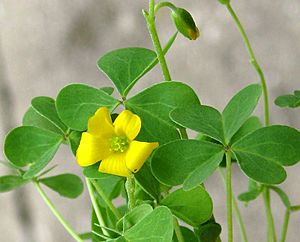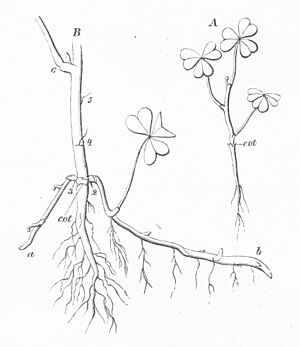Oxalis stricta facts for kids
Quick facts for kids Oxalis stricta |
|
|---|---|
 |
|
| Scientific classification | |
| Genus: |
Oxalis
|
| Species: |
stricta
|
| Synonyms | |
|
Oxalis europaea Jord. |
|
Oxalis stricta, also known as the common yellow woodsorrel or common yellow oxalis, is a small plant that grows in many places. You might also hear it called "lemon clover" or even "sourgrass" because of its tangy taste! This plant is originally from North America and parts of Eurasia. It can also be found in Great Britain, though it's not as common there.
You'll often spot yellow woodsorrel growing in woodlands, open fields called meadows, and in areas where the ground has been disturbed, like gardens or construction sites. When it's young, it stands up straight, but as it gets older, it tends to spread out and lie down. It's important not to confuse it with other similar plants in the same family that also have yellow flowers.
Contents
How Yellow Woodsorrel Grows
Many people consider common yellow woodsorrel a weed because it grows easily in gardens, fields, and lawns. It can grow well in both sunny and shady spots. The leaves of this plant are special: they are divided into three heart-shaped parts, which is common for plants in the Oxalis family. Each leaflet can grow up to 2 cm wide.
These leaves have a cool trick: they curl up at night, almost like they're going to sleep! This is called nyctinasty. Then, during the day, they open up to collect sunlight and make their own food through a process called photosynthesis.
When the plant's seed pods are ready, they open up very quickly and explosively if you touch them! This helps them shoot their seeds up to 4 meters (about 13 feet) away. It's a bit like how some other plants, like Impatiens, spread their seeds. The flowers of the plant have both male and female parts and bloom from July to October.
O. stricta usually likes dry or slightly moist alkaline soils. It grows best in sandy or loamy dirt that drains water well. It can even grow in ground that doesn't have a lot of nutrients.
Using Yellow Woodsorrel
Eating Yellow Woodsorrel
All parts of the yellow woodsorrel plant can be eaten, and they have a distinct tangy flavor, just like other plants in the Oxalis family. However, it's best to eat only small amounts. This is because the plant contains oxalic acid, which can make it harder for your body to absorb calcium.
The leaves and flowers are sometimes added to salads to make them look pretty and add a zesty taste. You can also chew the raw leaves, flowers, or even the green pods (but not the root) to quench your thirst. The green pods are juicy and crisp, with a tart flavor similar to rhubarb.
You can even use the leaves to make a drink that tastes a bit like lemonade! The whole plant can also be brewed to make an herbal tea that smells a bit like cooked green beans. The juice from the plant's greens has even been used as a substitute for vinegar. Yellow woodsorrel also has a lot of vitamin C, which is good for you!
Other Uses
An orange dye can be made by boiling the entire plant.
Traditional Uses
In the past, a poultice (a soft, moist mass of plant material) made from the plant was used to help treat swellings.
Images for kids
See also
 In Spanish: Acederilla para niños
In Spanish: Acederilla para niños



